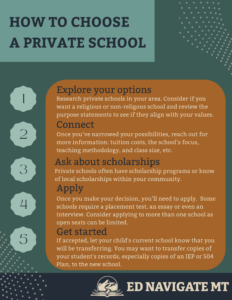Overview
Today, there are at least 125 private schools across Montana, serving over 11,000 students. Around 7% of all K-12 students in Montana are educated in private schools. From Catholic schools, to independent schools, to schools with special curricula, private schools offer students distinctive learning cultures.
Interested in considering a private school for your student? We’ve put together this ultimate guide to private school in Montana to answer your questions:
What to Expect
On the outside, a public school and a private school might look identical. But on the inside, there are key differences between the ways private and public schools operate.
Standards
Government-approved accreditation is optional for private schools in Montana. This means that private schools have flexibility to adopt their own standards for staffing, admissions, learning environments, class sizes, curriculum, textbooks, testing, budgeting, and more.
Private school facilities must still adhere to state regulations regarding safety, health, and building codes and must offer a minimum number of aggregate hours of instruction in order to qualify students for exemption from Montana’s compulsory public school enrollment laws.
Learning Environments
Private schools offer a wider variety of learning environments than traditional public schools. For instance, a private school may only admit a small number of students in order to provide more focused instruction. Private schools may also group students in classes by learning ability rather than chronological age like traditional public schools.
The largest private schools in Montana enroll hundreds of students, while the smallest private microschools may only enroll a handful. Some private schools operate in more traditional school facilities, while others embrace outdoor, hybrid, and other unconventional settings for instruction.
Instruction
Montana law requires nonpublic instruction to include at a minimum the core subjects taught in public schools, including:
- English language arts
- mathematics
- social studies
- science
- health
- arts
- career education
Beyond covering these core subjects in organized study, Private Schools are free to offer unique curriculum and classes that you won’t find in traditional public schools. For example, classical education models which emphasize the liberal arts and Greek/Roman academic traditions are soaring in popularity among private schools nationwide.
Religious/Non-Religious
65% of private schools in Montana openly offer religious-based instruction (mostly Christian and Catholic), while public schools uniformly focus on secular education.
Special Education Services
Private schools are not required by law to offer special education services. However, many private schools offer inclusive environments, welcoming all students. In fact, some private schools are founded to specifically meet the needs of students with disabilities, including the neurodiverse.
The Individuals with Disabilities Education Act (IDEA) protects all American children; therefore, even if your student is homeschooled or attends a private school, the district where you live is responsible for identifying and servicing your child’s special education needs under the Child Find section of IDEA. Inquire at your local district to learn about parental rights and district responsibilities under IDEA.
What do Private Schools Cost
Public schools are always tuition free, while private schools generate their own funding through tuition, private grants and fundraising. In Montana, the average annual private school tuition is about $8,000 for elementary schools and $9,000 for high schools.
Private schools can be more affordable than you think. Most private schools provide need-based or academic scholarships to help reduce tuition costs. Additionally, Student Scholarship Organizations like ACE Scholarships regularly offer financial assistance to hundreds of Montana students every year. Recently, the State of Montana created Education Savings Accounts to help families cover private school tuition for students with special needs.
Click the links below to learn more about financial assistance available to families attending private schools:
How to Choose A Private School

1. Explore your private school options
The first step is to research private school options in your area. You can use our School Finder tool to locate private schools near your zip code. Private schools vary widely, offering a range of religious and non-religious options to consider.
2. Connect
If a private school catches your interest, contact them for more information. Consider scheduling a tour or a phone call with the school administration. Some things that you may consider asking are: tuition costs, available scholarships, average class size, offered sports or extracurricular activities, and about extended-care options.
3. Ask about scholarships
Your initial step in finding scholarships is to inquire directly with the private schools you are considering. Schools are usually eager to provide information about local scholarship opportunities. Visit our Scholarships Guide to learn more.
4. Apply
Once you have made your choices on the best private school options for your child, it’s time to apply! Be aware that some schools may have specific entrance requirements for your child, such as essays, an interview, or a placement test for certain subjects.
5. Get Started
If your child is transferring from a public school, simply contact the enrollment office and let them know your student will not be returning the following year. The private school will provide you with the necessary paperwork and information to move forward.
More Resources
School Terms Glossary
Guide to Special Education provides an excellent resources for parents considering private school for their special needs child.
Think Inclusion is a great resource on including students with disabilities in schools.
U.S. Department of Education Individuals with Disabilities Education Act (IDEA) will provide parents with imperative information about their rights and schools’ responsibilities.
